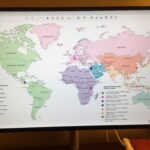As part of drafting an International Bill of Rights, Unite for Rights is uniting people, nonprofits, businesses, and governments to design and build an international judicial architecture for enforceable environmental and human rights.
Now as you read this, you may think it sounds like such an overwhelming task that you wonder how you can participate as a person, nonprofit, business, or government. The answer is, you can, even if you only spend one minute to become a Uniter with others on the spinning globe – and it may be one of the most powerful things that you do in your personal life, the life of a nonprofit, business, or government.
You see, there are some things, like a painting perhaps, that may be best done by one person. If Picasso were painting, it probably would not have been a good idea to say “hey Pablo, how about a little bit more green over there.” One, most likely, Picasso would have ignored you, and, two, if he had followed your advice it may be that some of the genius of the painting would have been lost.
Not so with the design of an international judicial architecture for an International Bill of Rights. Such an architecture covers a vast array of humanity, and all other living creature on land and sea, all parts of Earth. Only a broad array of input can design an International Bill of Rights and the courts to enforce it.
The exciting thing is that at this moment in history, we have the technological means to engage in such a vast endeavor. We can share thoughts in genuine ways, more comprehensively and inclusively, than ever before. It’s only a question of whether we are willing to do so.
To this end, Unite does not claim to have a perfect design for an international judicial architecture, but it has thought through a tapestry of courts in all countries: domestic, regional and international so that rights are not claims made as aspirations, but are enforceable in courts, with orders from Judges that can be issued. This strengthens and preserves our social contract with one another, and between those who govern and those who are governed.
In these times of rising athoritarianism, war, the demise of our environment, let us do something together — join us in creating an international movement, and let it be a movement, not for declarations, but for judicially enforceable environmental and human rights. Most of us have heard the saying “a picture is worth 1,000 words”. This map below lives up to that saying. It reflects the outcome of the plan for humanity that Unite for Rights is working to achieve. Using Rousseau’s standard of “taking humans as they are, and making the laws as they might be,” there is no better plan for humanity than the one reflected in this map.

CLICK BELOW TO SEE A CLEARER ENLARGEMENT OF THIS MAP!
2023 Jan 4 Map of Regional Courts
If you have a better plan, please share it. If not, I ask you to engage with and share this one.
In 25 years of studying and working to make the rights in the UDHR “juridical” (as I promised a former Dean of the Berkeley Law School, Frank Newman, I would do),  I’ve never heard anyone articulate a better plan for enforceable human rights than this map coupled with the draft International Bill of Rights on the website.
I’ve never heard anyone articulate a better plan for enforceable human rights than this map coupled with the draft International Bill of Rights on the website.
It was understood when the UDHR was created that there would need to be Regional Courts to enforce rights, and the European Court of Human Rights is a prime example. As John Humphrey, the Canadian professor who did much of the research for the UDHR has written, “if the international community ever becomes really serious about human rights, the European example will be applied on the universal scale.” This map shows how that can happen.
Humanity must exercise its free will over the authoritarians who continue to dominate nation states, and much of this world’s valuable resources, including human resources, or things will get worse, not better.
We either make stronger rules for those who govern, and create independent courts that have the power to exercise judgments against those them, or we all live with continued despotism and environmental ruin. Blame and shame will never be enough. As Einstein said “doing the same thing over and over and expecting a different result is the definition of insanity” – just look at the Ukraine – Putin declared he would not follow the decisions of the European Court of Human Rights and nothing was done. The answer is not to say “courts don’t work,” but to make them stronger.
Also, the repetitive creation of new human rights instruments that do no more than require more reports should stop. It’s time to demand enforceable documents and object if something less than that is created, as was recently done at the United Nations Summit of the Future.
At some point in humanity’s evolution, leaders of all countries must be responsible to Courts with independent Judges to enforce the rights that humans have reserved for themselves through Bills of Rights. A Bill of Rights gives limited power to those who govern. This is a conservative fundamental principle.
In 2025, all human rights organizations, philanthropies, academics, and civil rights groups in all countries should bind together to use their collective clout and become “lights for rights” on the Unite for Rights spinning globe to show their support for an International Bill of Rights, enforceable in the courts of all countries. The framers of the UDHR always an intended linkage between the UDHR and the Courts depicted in this map. 2025 is the time to link the two.
Thanks for helping to make this happen.


Leave a Reply